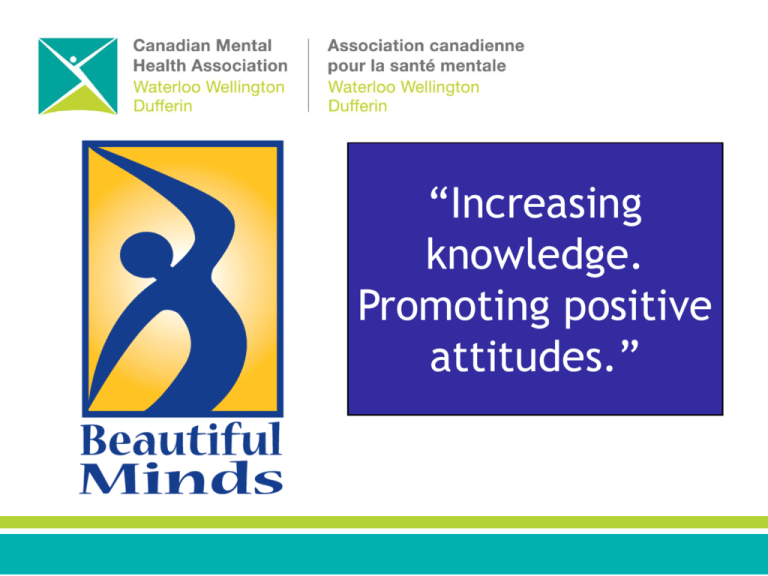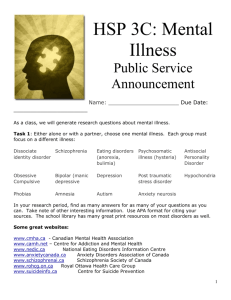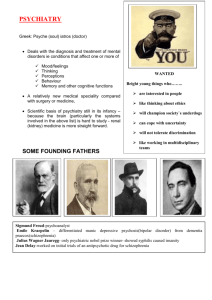PowerPoint slides
advertisement

“Increasing knowledge. Promoting positive attitudes.” The following are definitions of “stigma” taken from different sources and historical periods: • “A mark or sign of disgrace or discredit.” • “A visible sign or characteristic of a disease.” – The Concise Oxford Dictionary, 1990 • “An attribute which is deeply discrediting.” – Goffman, E., Stigma: The management of spoiled identity, 1963 • “A distinguishing mark or characteristic of a bad or objectionable kind; a sign of some specific disorder, as hysteria.” • “A mark made upon the skin by burning with a hot iron, as a token of infamy or subjection; a brand.” • “A mark of disgrace or infamy; a sign of severe censure of condemnation, regarded as impressed on a person or thing.” – The Shorter Oxford English Dictionary Stereotype: “A person or thing that conforms to an unjustifiably fixed impression or attitude.” Prejudice: “A preconceived opinion.” Discrimination: “Unfavourable treatment based on prejudice.” Diagnosis or believed diagnosis of mood disorder, unless otherwise noted Actors/Entertainers/Directors Marlon Brando Drew Carey Jim Carrey Dick Clark John Cleese Rodney Dangerfield Richard Dreyfuss Patty Duke Frances Ford Coppola Audrey Hepburn Anthony Hopkins Ashley Judd Margot Kidder Vivien Leigh Joan Rivers Roseanne Winona Ryder Charles Schultz Rod Steiger Damon Wayans Robin Williams Artists Paul Gaugin Vincent van Gogh Michelangelo Vaslov Nijinski (dx: schizophrenia) Georgia O’Keefe Jackson Pollock Athletes Lionel Aldridge (dx: schizophrenia) Oksana Baiul Dwight Gooden Peter Harnisch Greg Louganis Elizabeth Manley Jimmy Piersall Monica Seles Darryl Strawberry Bert Yancey Authors/Journalists Hans Christian Andersen F. Scott Fitzgerald Mary Shelly James Barrie John Kenneth Galbraith William Styron William Blake Ernest Hemingway Leo Tolstoy Agatha Christie John Keats Mark Twain Michael Crichton Larry King Mike Wallace Charles Dickens Eugene O’Neill Walt Whitman Emily Dickinson Sylvia Plath Tennessee Williams William Faulkner Edgar Allen Poe Virginia Wolf Business leaders Howard Hughes (dx: depression/OCD) J.P. Morgan Ted Turner Sigmund Freud Stephen Hawking Sir Isaac Newton Scientists Charles Darwin Composers/Musicians/Singers Irving Berlin Sheryl Crow Marie Osmond Ludwig van Beethoven John Denver Charles Parker Karen Carpenter Stephen Foster Cole Porter (dx: anorexia) Peter Gabriel Bonnie Raitt Ray Charles Janet Jackson Axl Rose Frederic Chopin Billy Joel Robert Schumann Eric Clapton Elton John Paul Simon Kurt Cobain Sarah McLachlan James Taylor Leonard Cohen Charles Mingus Peter Tchaikovshy Natalie Cole Alanis Morissette Political figures/World Leaders Alexander the Great Diana, Princess of Wales Ralph Nader Napoleon Bonaparte Tipper Gore Florence Nightingale Barbara Bush Thomas Jefferson George Patton Winston Churchill George Stephanopolous (See hand out) (See hand out) What is Mental Illness? 1) “1 person in 100 develops schizophrenia.” 2) “A person who has one or two parents with mental illness is more likely to develop mental illness.” 3) “Mental illness is contagious.” 4) “Mental illness tends to begin during adolescence.” 5) “Poor Parenting causes schizophrenia.” 6) “Drug use causes mental illness.” 7) “Mental illness can be cured with willpower.” 8) “People with mental illness never get better.” 9) “People with mental illness tend to be violent.” 10) “All homeless people are mentally ill.” 11) “Developmental disabilities are a form of mental illness.” 12) “People who are poor are more likely to have mental illness than people who are not.” 1 in 5 Ontarians experience a mental illness in their lifetime. 3 12% of Ontario students grades 7-12 reported at least one visit to a mental health 1 Approximately 5% professional in the previous 12 months. of Ontario students grades 7-12 are at risk for depression. 1 Psychological distress significantly increases with grade, peaking in the 12th grade. 1 Approximately 11% of Ontario students grades 7-12 reported that they had seriously considered suicide during the past year. 1 Mental Health Statistics for Ontario Suicide is a major risk for individuals with schizophrenia. With other mental illnesses, such as major depression, bipolar disorder, and borderline personality disorder, the risk of suicide is also higher than the general population. 3 Mental illnesses often develop during adolescence and young adulthood. 2 Mood disorders (major depressive disorder, bipolar disorder, dysthymic disorder, or postpartum depression) affect individuals of all ages but usually first appear in adolescence or young adulthood. 2 Mental Illness is a disturbance in thoughts and emotion that decreases a person’s capacity to cope with challenges of everyday life. Mood Disorders are persistent changes in mood caused by biochemical imbalances in the brain. Major depressive disorder and Bipolar disorder are two types of mood disorders. MAJOR DEPRESSIVE DISORDER is a depressed mood accompanied by symptoms such as: loss of interest in life, irritability, sadness, difficulty sleeping or sleeping too much, decreased or increased appetite, lack of concentration, sense of worthlessness, guilt, and in some cases thoughts of suicide. BIPOLAR DISORDER is a cycle of depressed mood, “normal” mood, and mania. Mania is an elevated, exaggerated mood accompanied by symptoms such as: inflated self-esteem or confidence, a decreased need for sleep, increased energy, increased sexual drive, poor judgment, increased spending, agitation, non-stop talking, and increased involvement in pleasurable and possibly dangerous activities. Psychosis is the active state of experiencing hallucinations or delusions and can be organic (mental illness) or drug-induced. SCHIZOPHRENIA is a disturbance involving delusions, hallucinations, disorganized speech and/or disorganized or catatonic behaviour. Delusions are false beliefs or misinterpretations of situations and experiences. Hallucinations are auditory, visual, olfactory (smell), gustatory (taste), or tactile (touch) experiences without an external stimulus. Hallucinations and delusions can result in a deterioration of a person’s ability to function at work, school, and/or socially. Anxiety Disorders are associated with feelings of anxiousness, combined with physiological symptoms that interfere with everyday activities. Obsessive-compulsive Disorder, Post-Traumatic Stress Disorder, and Phobias are types of anxiety disorders. OBSESSIVE-COMPULSIVE DISORDER is marked by repeated obsessions and/or compulsions that are so severe they interfere with everyday activities. Obsessions are disturbing intrusive thoughts, ideas, or images that cause marked anxiety or distress. Compulsions are repeated behaviours or mental acts intended to reduce anxiety. POST-TRAUMATIC STRESS DISORDER is the re-experiencing of a very traumatic event, accompanied by feelings of extreme anxiety, increased excitability, and the desire to avoid stimuli associated with the trauma. The trauma could be related to such incidents as military combat, sexual assault, physical attack, robbery, car accident, or natural disaster. PHOBIAS are significant and persistent fears of objects and situations. Exposure to the object or situation causes extreme anxiety and interferes with everyday activities or social life. Specific phobias have to go with objects or situations – for example, germs or heights. Social phobias have to do with social situations or performance situations where embarrassment may occur – for example, public speaking or dating. A Personality Disorder is a pattern of inner experience and behaviour that is significantly different from the individual’s culture, is pervasive and inflexible, is stable over time, and leads to distress of impairment. Personality disorders usually begin in adolescence or early adulthood. DISSOCIATIVE IDENTITY DISORDER, formerly known as “multiple personality disorder,” is the presence of two or more distinct identities that alternately control a person’s behaviour. It reflects a failure to make connections between identity, memory, and consciousness. Known by the general public as “split personality,” there is now controversy as to whether or not it is a real diagnosis. Eating Disorders are a range of conditions involving an obsession with food, weight, and appearance that negatively affects a person’s health, relationships, and daily life. Stressful life situations, poor coping skills, socio-cultural factors regarding weight and appearance, genetics, trauma, and family dynamics are thought to play a significant role in the development of eating disorders. ANOREXIA NERVOSA is characterized by an intense and irrational fear of body fat and weight gain, the strong determination to become increasingly thinner, and the refusal to maintain a normal weight (for height and age), and a distorted body image. BULIMIA NERVOSA is characterized by self-defeating cycles of binge eating and purging. Bingeing is the consumption of large amounts of food in a rapid, automatic, and helpless fashion that leads to physical discomfort and anxiety about weight gain. Purging follows bingeing and can involve induced vomiting, restrictive dieting, excessive exercising, or using laxatives and diuretics. The following are factors that may contribute to the development of mental illness: • • • • • chemical imbalance substance use traumatic life events heredity other illnesses Biological treatments: • medication • electroconvulsive therapy (ECT) Psychosocial treatments: • psychotherapy • self-help groups • family support and involvement • community supports Hope Self-Direction Individualized and PersonCentered Responsibility Empowerment Respect Peer Support StrengthsBased Holistic Non-Linear See handout • • • • • • • • • • Self-Direction Individualized & Person-Centered Empowerment Holistic Non-Linear Strength-based Peer Support Respect Responsibility Hope EMPOWERING LANGUAGE: • People / person with mental illness DISEMPOWERING LANGUAGE: • The mentally ill • Victims, suffering • Crazy, wacko, lunatic, psycho, psychopath, demented • Person with schizophrenia • Person with bipolar disorder DO: • Put the person first • Talk with people • Become informed about mental illness • Take action in your community and school (e.g. Walk for Schizophrenia) DON’T: • Refer to people by their illness • Talk about people • Be judgmental Here are some strategies for supporting someone with a mental health problem: • Be supportive and understanding. • Spend time with that person. Listen to him or her. • Never underestimate the person’s abilities. • Encourage the person to follow his or her. treatment plan and seek out support services. • Become informed about mental illness. • If you are a close friend or family member of someone who has mental illness, make sure you get support as well. Crisis training, self-help, and/or individual counselling will help you become a better support person. • If you think the person needs help, especially if he or she mentions having thoughts of suicide, don’t keep it a secret (even if the person may have asked you to). Tell his or her parents or someone else who can help.






